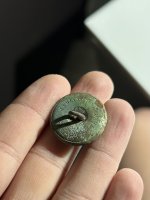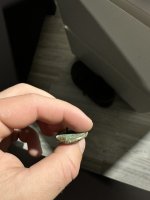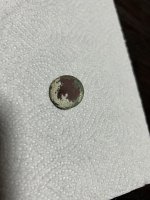WHAT DOES EXTRA RICH MEAN?
You are using an out of date browser. It may not display this or other websites correctly.
You should upgrade or use an alternative browser.
You should upgrade or use an alternative browser.
treble gilt-extra rich
- Thread starter sajtikus
- Start date
Red-Coat
Gold Member
Welcome to Tnet. You've posted in the section for people needing technical assistance with the website but, no matter, and the Mods will probably move your post to a mare appropriate section.
Gilt buttons became fashionable in Britain in the mid-to-late 1790s, with the gilding achieved using a closely-guarded process that coated then with an amalgam of mercury and gold (electro-plating didn’t appear until the 1840s). The term ‘gilt’ was sometimes misleadingly used to describe a golden-colour finish with little or no actual gold used, often so poor that the colour would disappear within a few weeks of wear. Some of the gold-coloured lacquers would also fade when exposed to sunlight.
These malpractices led to legislation in Britain in 1796 to inhibit the less ethical makers, with the approved minimum amount of gold for a button to be called “gilt” being set at 1/96th of an ounce per gross of 1 inch buttons. The terms “double gilt” and “treble/triple gilt” were intended to apply to consequent multiples of that amount for superior finishes. Manufacturers took to using terms such as “rich”, “extra-rich”, “extra-fine”, “extra-strong” and also “orange” to circumvent the legislation and/or promote the quality of their buttons (with varying degrees of honesty).
Indented backmarks (like yours) began appearing around 1810 and the previously-used raised backmarks aren’t usually seen after about 1840. During the early 1800s the process details for gilding ‘leaked’ to American producers. Unless a maker name is part of the backmark or there are other identification details, it isn’t usually possible to distinguish American buttons from British ones, except when the word “colour” appears with its British spelling.
Gilt buttons became fashionable in Britain in the mid-to-late 1790s, with the gilding achieved using a closely-guarded process that coated then with an amalgam of mercury and gold (electro-plating didn’t appear until the 1840s). The term ‘gilt’ was sometimes misleadingly used to describe a golden-colour finish with little or no actual gold used, often so poor that the colour would disappear within a few weeks of wear. Some of the gold-coloured lacquers would also fade when exposed to sunlight.
These malpractices led to legislation in Britain in 1796 to inhibit the less ethical makers, with the approved minimum amount of gold for a button to be called “gilt” being set at 1/96th of an ounce per gross of 1 inch buttons. The terms “double gilt” and “treble/triple gilt” were intended to apply to consequent multiples of that amount for superior finishes. Manufacturers took to using terms such as “rich”, “extra-rich”, “extra-fine”, “extra-strong” and also “orange” to circumvent the legislation and/or promote the quality of their buttons (with varying degrees of honesty).
Indented backmarks (like yours) began appearing around 1810 and the previously-used raised backmarks aren’t usually seen after about 1840. During the early 1800s the process details for gilding ‘leaked’ to American producers. Unless a maker name is part of the backmark or there are other identification details, it isn’t usually possible to distinguish American buttons from British ones, except when the word “colour” appears with its British spelling.
Upvote
2
- Thread starter
- #3
Thank you for your informations!Welcome to Tnet. You've posted in the section for people needing technical assistance with the website but, no matter, and the Mods will probably move your post to a mare appropriate section.
Gilt buttons became fashionable in Britain in the mid-to-late 1790s, with the gilding achieved using a closely-guarded process that coated then with an amalgam of mercury and gold (electro-plating didn’t appear until the 1840s). The term ‘gilt’ was sometimes misleadingly used to describe a golden-colour finish with little or no actual gold used, often so poor that the colour would disappear within a few weeks of wear. Some of the gold-coloured lacquers would also fade when exposed to sunlight.
These malpractices led to legislation in Britain in 1796 to inhibit the less ethical makers, with the approved minimum amount of gold for a button to be called “gilt” being set at 1/96th of an ounce per gross of 1 inch buttons. The terms “double gilt” and “treble/triple gilt” were intended to apply to consequent multiples of that amount for superior finishes. Manufacturers took to using terms such as “rich”, “extra-rich”, “extra-fine”, “extra-strong” and also “orange” to circumvent the legislation and/or promote the quality of their buttons (with varying degrees of honesty).
Indented backmarks (like yours) began appearing around 1810 and the previously-used raised backmarks aren’t usually seen after about 1840. During the early 1800s the process details for gilding ‘leaked’ to American producers. Unless a maker name is part of the backmark or there are other identification details, it isn’t usually possible to distinguish American buttons from British ones, except when the word “colour” appears with its British spelling.
Here are some pictures. You can see some gold shining on the edge.
Attachments
Upvote
1
- Thread starter
- #4
Welcome to Tnet. You've posted in the section for people needing technical assistance with the website but, no matter, and the Mods will probably move your post to a mare appropriate section.
Gilt buttons became fashionable in Britain in the mid-to-late 1790s, with the gilding achieved using a closely-guarded process that coated then with an amalgam of mercury and gold (electro-plating didn’t appear until the 1840s). The term ‘gilt’ was sometimes misleadingly used to describe a golden-colour finish with little or no actual gold used, often so poor that the colour would disappear within a few weeks of wear. Some of the gold-coloured lacquers would also fade when exposed to sunlight.
These malpractices led to legislation in Britain in 1796 to inhibit the less ethical makers, with the approved minimum amount of gold for a button to be called “gilt” being set at 1/96th of an ounce per gross of 1 inch buttons. The terms “double gilt” and “treble/triple gilt” were intended to apply to consequent multiples of that amount for superior finishes. Manufacturers took to using terms such as “rich”, “extra-rich”, “extra-fine”, “extra-strong” and also “orange” to circumvent the legislation and/or promote the quality of their buttons (with varying degrees of honesty).
Indented backmarks (like yours) began appearing around 1810 and the previously-used raised backmarks aren’t usually seen after about 1840. During the early 1800s the process details for gilding ‘leaked’ to American producers. Unless a maker name is part of the backmark or there are other identification details, it isn’t usually possible to distinguish American buttons from British ones, except when the word “colour” appears with its British spelling.
Upvote
0
WHAT DOES EXTRA RICH MEAN?


Upvote
0
Top Member Reactions
-
 2245
2245 -
 1119
1119 -
 1016
1016 -
 910
910 -
 860
860 -
 778
778 -
 773
773 -
 729
729 -
 609
609 -
 508
508 -
 491
491 -
 478
478 -
O
444
-
 438
438 -
 421
421 -
 411
411 -
 407
407 -
 387
387 -
 380
380 -
 374
374
Users who are viewing this thread
Total: 2 (members: 0, guests: 2)







